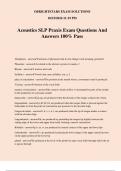©BRIGHTSTARS EXAM SOLUTIONS
10/23/2024 11:19 PM
Acoustics SLP Praxis Exam Questions And
Answers 100% Pass
Allophones - answer✔Variations of phonemes that do not change word meaning, green/red
Phonemic - answer✔As related to the abstract system of sounds, //
Rhyme - answer✔A nucleus and coda
Syllabics - answer✔Vowels that carry syllables, em, n, L
place of articulation - answer✔The position in the mouth where a consonant sound is produced
Voicing - answer✔vibration of the vocal folds
manner of articulation - answer✔the extent to which airflow is interrupted by parts of the mouth
in the production of consonant sounds
linguavelar - answer✔g,k,ng, are produced when the dorsum of the tongue contacts the velum
linguapalatal - answer✔j,r,d3,tS,3,S, are produced when the tongue blade is pressed against the
hard palate to from the point of constriction just posterior to the alveolar ridge
Lingua-alveolars - answer✔t, d, s, z, n, l, are produced when the tip of tongue makes a contact
with the alveolar ridge
Linguadentals - answer✔th, are produced by protruding the tongue tip slightly between the
cutting edge of the lower and upper front teeth, forming a narrow constriction
Bilabials - answer✔p, b, m, w, are produced by mutual contact of the upper and lower lips
Labiodentals - answer✔f,v are produced by placing the lower eduge of the upper central incisors
on the upper portion of the lower lip
glottal - answer✔H, produced at the level of the glottis by open vocal folds through which the air
is passes through
, ©BRIGHTSTARS EXAM SOLUTIONS
10/23/2024 11:19 PM
cognate pairs - answer✔Sounds that are identical except for voicing (e.g., p and b).
Nasals - answer✔m,n,ng, are produced by lowering the velum to keep the velopharyngeal port
open
Fricatives - answer✔f, v, θ, ð, s, z, ʃ, ʒ, h, friction, a hissing, quality, that results from the
continuous forcing of air through a narrow constriction
Affricates - answer✔tʃ, dʒ, begin as stops and end as fricatives
stops - answer✔p, b, t, d, k, g, produced by complete constristion or closure of the voocal tract at
some point
Glides - answer✔w, j, also called semivowels and sonorants, produced by a quick transition of
the articulators, from partially constricted to more open
Liquids - answer✔l, r, with the least oral cavity restriction of all consonants
Vowel Diagram - answer✔
Assimilation - answer✔Causes a sound to change to a different sound, pomputer/computer
Suprasegmentals - answer✔Prosody of speech; length, stress, rate, pitch, volume, and juncture
(intonation and pausing)
pitch - answer✔auditory perception of the frequency with which the vocal folds vibrate, mass,
tension, elasticity of vocal folds
Compression - answer✔The part of a longitudinal wave where the particles of the medium are
close together.
Rarefaction - answer✔a part in a longitudinal wave where the particles are spread apart
simple harmonic motion - answer✔sine wave, referes to the back and froth movement particles
when the movement is symmetrical and periodic
sinusoidal motion wave - answer✔a wave with a horizontal/vertical symmetry, contains one
peak, crest, valley, a trough, contains one single frequency
CSG system - answer✔metric system of measuring length of centimeters, time in seconds, and
mass in grams.
dyne - answer✔n. The force which, applied to a mass of one gram for 1 second, would give it a
velocity of 1 cm/s.




